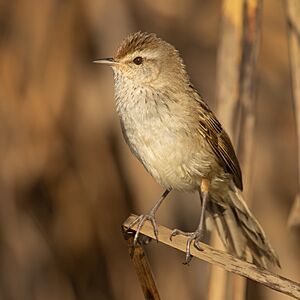Little grassbird facts for kids
Quick facts for kids Little grassbird |
|
|---|---|
 |
|
| Adult | |
 |
|
| Juvenile | |
| Conservation status | |
| Scientific classification | |
| Genus: |
Poodytes
|
| Species: |
gramineus
|
| Synonyms | |
|
Megalurus gramineus |
|
The little grassbird (Poodytes gramineus) is a small bird found in Australia and parts of Indonesia. It belongs to a bird family called Locustellidae. You can often find these birds in wet areas like reed beds, swamps, and salt marshes in Southeastern Australia. Both male and female little grassbirds look very similar.
These birds are usually hard to spot because they have dull colors and blend in well with their surroundings. You'll probably hear their calls more often than you see them! They are known to 'talk' back to people sometimes. Little grassbirds eat insects and other tiny creatures. They like to stay hidden in thick plants and don't usually migrate, meaning they move around without a set pattern.
Contents
What's in a Name?
Birds are grouped into families to help scientists understand them. The little grassbird is part of a family called Locustellidae. This family name comes from the word Locustella, which is a type of grasshopper.
The little grassbird was first described in 1845 by an English bird expert named John Gould. He gave it the scientific name Sphenoeacus gramineus. Later, it was moved to a different group, or genus, called Poodytes. This name comes from ancient Greek words meaning "grass" and "diver," which fits a bird that lives in grassy wetlands! The second part of its name, gramineus, is Latin for "grassy" or "grass-like."
Sometimes, you might hear the little grassbird called by other names, like Grassbird or Little Marshbird.
Different Types of Little Grassbirds
There are four main types, or subspecies, of the little grassbird:
- Poodytes gramineus papuensis – Found in West Papua, Indonesia.
- Poodytes gramineus goulburni – Found across Northern Territory, South Australia, Queensland, New South Wales, and Victoria.
- Poodytes gramineus thomasi – Found in Western Australia.
- Poodytes gramineus gramineus – Found in Tasmania and the Bass Strait islands.
How to Spot a Little Grassbird
The little grassbird is about 13 to 15 centimeters long. It has an olive-brown or brown-grey body. You might notice a pale stripe above its eye. Its throat, head, and cheeks have dark grey streaks. The upper part of its body is streaked dark grey, and its belly is a lighter, streaky grey. Its wing feathers are dark with white edges.
It's hard to tell male and female grassbirds apart just by looking at them. However, males are usually a bit bigger than females, except for their beaks.
What Does it Sound Like?
You'll often hear the little grassbird before you see it. Its call is a sad-sounding, three-note whistle, like "tee-ti-teee." During breeding season, it makes a repeated sound of two or three soft whistles, like "p-pee-pee."
Similar Birds
The tawny grassbird looks a bit like the little grassbird but is slightly bigger and more reddish-brown. The striated fieldwren is also similar, but it has yellow underparts and clear white eyebrows.
Where Little Grassbirds Live
Little grassbirds live across Eastern Australia and Tasmania. They can also be found inland in Central Australia and in South-Western Australia. They are also present in West Papua, Indonesia, though they are not very common there.
These birds prefer to live in thick wetland plants. This includes sedges, reeds, and tall grasses. They also use shrubs like lignum, saltmarshes, and low mangroves. After heavy rains, little grassbirds might move into temporary wetlands.
Life and Habits
What They Eat
Little grassbirds mostly eat insects and other small creatures like spiders. They usually stay hidden in the thick grass and swamp plants while they hunt for food.
Reproduction and Life Cycle
Little grassbirds usually breed between August and December, or after it rains. They build deep, cup-shaped nests. These nests are made from grass, twigs, and stems, and are lined with soft feathers, often from the Australasian swamphen. They usually place their nests in tall grasses, reeds, or low shrubs.
A female grassbird typically lays 3 to 5 eggs. These eggs are whitish or pink-white with grey speckles. Studies have shown that there are often more male grassbirds than females in breeding areas.
Conservation Status
The little grassbird is listed as a species of "Least Concern" by the IUCN. This means that its population is stable and not currently at risk. In fact, the number of little grassbirds seems to be increasing. BirdLife Australia also considers them secure in all states.
Gallery



